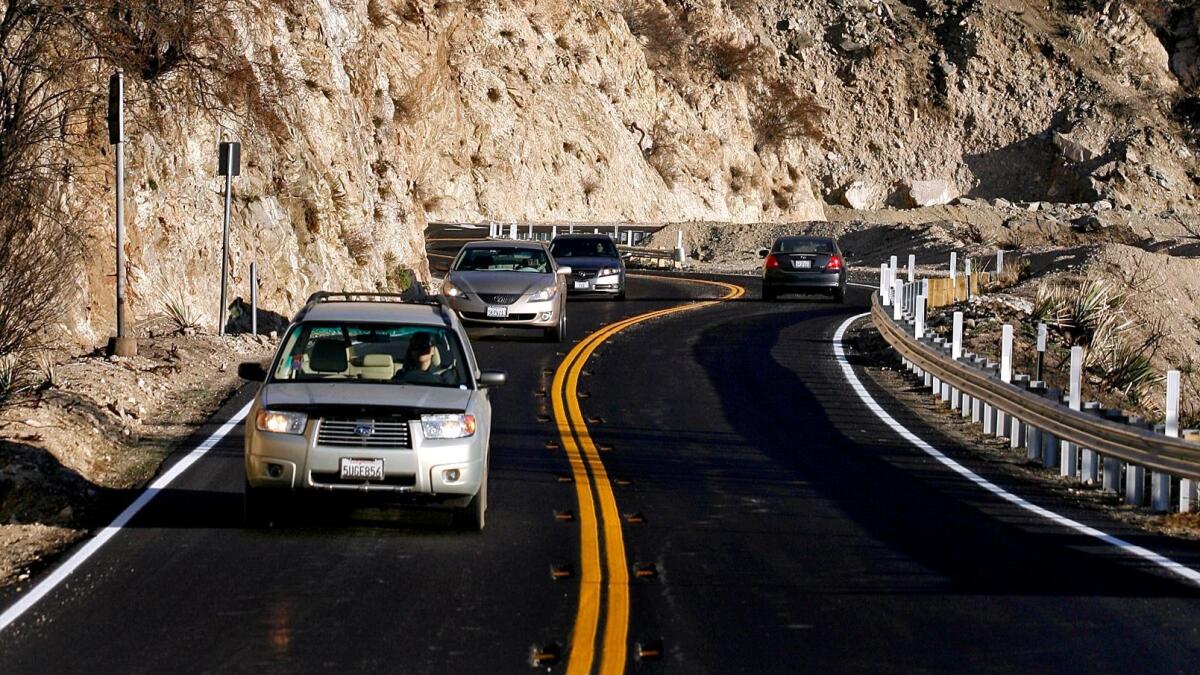Commentary: Highway through the San Gabriels gives him a wild ride — in just one ‘interminable’ mile

- Share via
Angeles Crest Highway is widely known as one of the most dangerous roads in Southern California. After traveling on it for a thousand times (yes, a thousand) I feel sure that description doesn’t do it justice. It must be one of the most dangerous in the world.
Too extravagant? Well, consider this: it has what most of the renowned mountain roads have — a narrow, twisting, steep way through wilderness with drops of hundreds of feet on one side and cliffs of unstable rock on the other. Going north from the southern boundary of the national forest, it has five hairpin bends in the first mile.
It starts in the benign climate of La Cañada and, connecting to the Angeles Forest Highway, ends in the desert at Palmdale but in the meantime it climbs to nearly 5,000 feet exposed to all the elements. Thick clouds roll in without warning and can cut visibility to a few feet. In the higher reaches, drizzle can freeze on the windshield. The rainstorms are legendary.
But, in addition, it has what few other mountain roads have: an almost unending flow of traffic coming one way for two hours or so in the early morning and going the other way from mid-afternoon. These drivers have come at least 40 miles — we know that because there is no habitation at all for 40 miles — and many of them from a lot farther. I don’t think I have ever turned onto it without seeing at least one car accelerating its way up, as it feels liberated from the very edge of Los Angeles or accelerating on its way down as the speed limit goes up from a theoretical 40 mph to 45. And that is true even when I leave home around four in the morning to catch a six o’clock flight from LAX.
By six, the flow is in full spate. Driving against it is a continual grating on the nerves, especially at this time of the year and until the days lengthen again. I am on the road just one mile, going to the trailhead for a daily hike, but around every bend comes a string of cars, 20, 30, 50 at a time, three or four car lengths apart, all relentlessly pushing the car in front if it should slow momentarily, one set of headlights immediately following another. There is a brief respite, then the next string begins, headlights sweeping across your face, momentarily blinding you, followed by the next set coming from a different angle as the road changes direction, then another. In these conditions a mile is interminable.
Then, as if this was not punishment enough, the fates throw in from time to time another hazard few mountain roads can claim. You round a bend and almost under your wheels is a cyclist, generally two cyclists, sometimes with a vestigial back light, sometimes a bright disorienting flashing light. Instantly you have to make a decision: do you brake suddenly and risk being hit by car that has been crowding you all the way up or speed up while the roadway is clear for a few yards ahead? It’s true such occasions are rare but into your already overloaded nervous system you have to factor in this possibility every day or risk an extended diet of dry bread and water or whatever they serve now for manslaughter.
Reading this over, I can’t believe I use that road at all, let alone five or six days a week and not because I have to, but because I begrudge any day that goes by without spending time on a trail in our empty, rugged mountains.
For 50 years, I have thought I had hit the bottommost rung of travel when one day I was in Afghanistan as a newspaper reporter. It was on a bitterly cold day that I caught a crowded bus going through the savage Kabul Gorge when the only seat left was on the roof. It was a regular bus roof, no luggage rack to hold on to, you just supported yourself by spreading out your frozen arms on both sides. But there were already five or six people up there who cheerfully hauled me up, so it was obviously routine.
I traveled probably 30 miles like that and the only diversion from the unending struggle not to slide toward the rounded edges of the roof was when the bus conductor climbed up, as the bus was moving, to collect fares. I remember digging out of my pocket a 100 Af bill, which had a slight tear in it, and holding it out to pay. In an instant, the piercing wind tore the bill in two and one half was whipped away while I was left gazing in astonishment at the other half in my numb fingers. All around me I heard a collective sigh, “Aaaaaiiiiiii,” such as you might hear at a funeral. At the rate of exchange then, 100 Afs were worth perhaps $2, an unheard of case of money being literally blown away. They probably still talk about it. Those who haven’t fallen off the top of a bus, that is.
Returning to Kabul, I flagged a bus and was instantly in luxury, standing of course for 30 miles in the swaying, shuddering claptrap of a vehicle, shoulder to shoulder with the packed people and their chickens and goats going to market, but inside, warm and cozy.
So, I’m prepared to concede that our Angeles Crest Highway is not the most dangerous road in the world. But I don’t think anyone can dispute that it’s in the Premier League — and, for a settled, good-natured city like ours to have something that wild running through the middle of it is like having a mad uncle barricaded in the attic.
Reg Green can be reached via www.nicholasgreen.org